Who is Laura Dianti? Enveloped in a blue dress with a yellow veil that shows her white undershirt, Laura shows a lot of skin and a lot of underwear. On her head she sports an exotic turban heavy with pearls and, like her servant, wears an earring.
Yellow was long associated with outsiders, and in some parts of Italy, yellow veils marked out sex workers. Laura, from a humble background, was the concubine of the Duke of Ferrara, Alfonso d’Este, dependent on his favour, living on her wits and beauty. https://twitter.com/profjill_burke/status/1131594757032091648
Natural beauty was associated with virtue, women’s looks were closely scrutinised. Whiteness of skin was an obsession and the parvenu nobles of 16th c Italy tried to emphasise their natural fitness to rule. Beauty recipes for skin whitening are very common
https://sites.eca.ed.ac.uk/renaissancecosmetics/cosmetics-recipes/skin/
https://sites.eca.ed.ac.uk/renaissancecosmetics/cosmetics-recipes/skin/
Contrasting your whiteness with a darker skinned servant was popular. In 1491 Alfonso’s sister, Isabella, tried to buy a little girl of 4 years old with skin "as black as possible". She was in competition with her mother who was breeding a "race" of black servants.
Isabella's mother was the duchess of Ferrara: it’s possible that the black child portrayed here to set off Dianti's luminous white skin was a result of her breeding programme. Both Dianti and her companion are creations of the Este, ornaments of the court, subject to their whim.

 Read on Twitter
Read on Twitter



